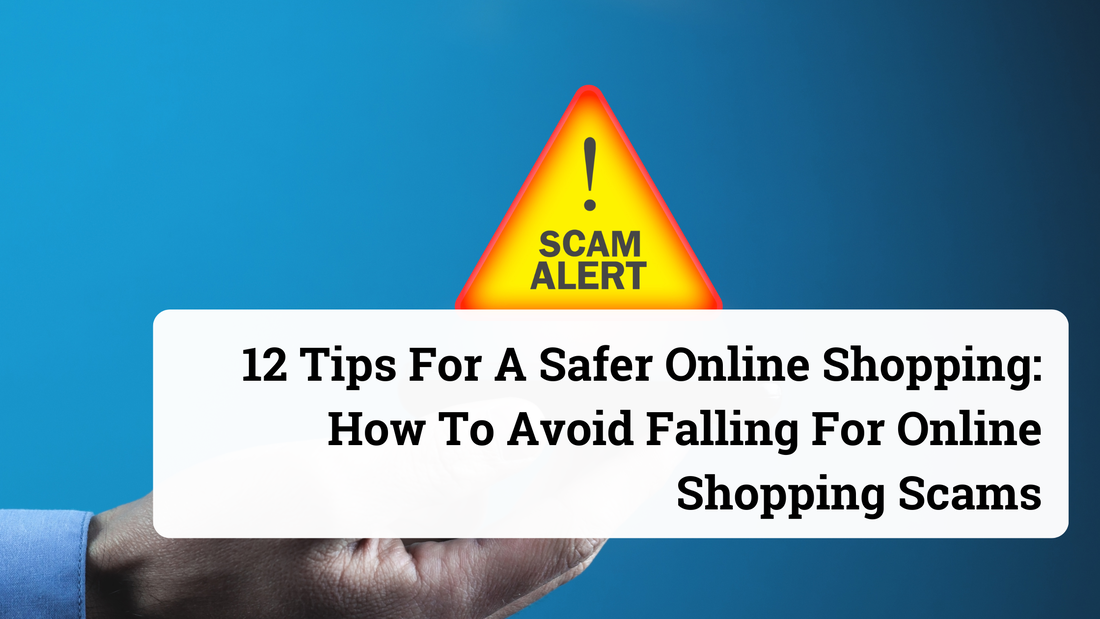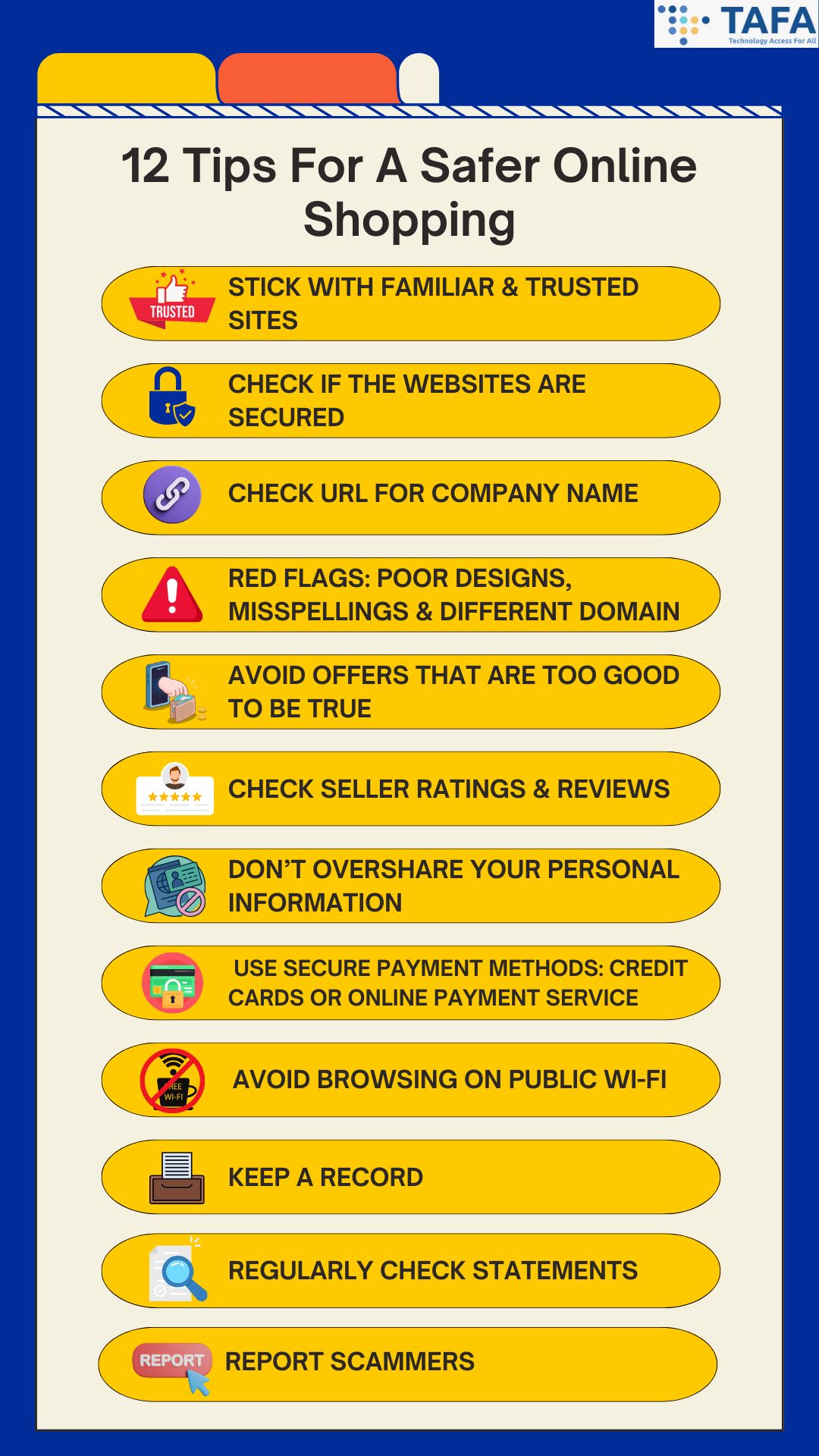|
Online shopping has made possibilities endless. From the comfort of your home, you can browse, choose, and purchase anything you desire. However, as the digital marketplace expands, so do the perils that come with it. There are many threats that lurk online, and one such threat are online shopping scams (which can also be known as ecommerce fraud). From stealing personal and financial information to bogus returns, the highest numbers impacted by online shopping scams are consumers. Tips To Protect Yourself Against Online Shopping Scams 1) Stick With Familiar & Trusted Sites
It is highly recommended to shop directly from online retailers that you are familiar with and trust. Avoid typing the name of the retailer into your browser bar, as a tiny typo can lead you to a fake site that imitates the real one. These fake sites may lead you to divulging personal and financial information. It is best to bookmark your trusted and familiar sites to ensure you are going to their legitimate sites. 2) Check If The Websites Are Secured Remember ‘S’ stands for SECURE. Before you visit an e-commerce site, the first thing you must do is to inspect the URL of the page. Secure sites use HTTPS, and not HTTP. This indicates a secure, encrypted connection. A padlocked symbol should also appear at the address bar. This means that you are safely connected to the website. Ensure to share sensitive information (such as your personal and payment details) ONLY on official secured websites. However, this does not mean that you are completely safe, as many phishing sites do use HTTPS. 3) Check URL For Company Name In addition to checking for HTTPS, check the URL to ensure that the company name is included, and ensure that the company name is spelt correctly. This will help you determine if the site is actually operated by said company or it’s a scam site. 4) Red Flags: Poor Designs, Misspellings & Different Domain Check and recognize for signs of potentially fraudulent websites such as misspelt words, typos, unprofessional designs, and low resolution images. If the website does not contain any branding, be cautious of the website. Also beware of scam sites that will use different top-level domains (e.g. using .net instead of .com). 5) Avoid Offers That Are Too Good To Be True Do you always see ads on your social media that offer huge discounts, way cheaper than usual products, or free offers which you only have to pay shipping for? This is a common tactic that cybercriminals use to bait unsuspecting shoppers with incredible deals to entice them into falling for their scams. It is also recommended to compare prices before buying - as unusually low prices could alert you that this website could be a scam. Remember if an offer looks too good to be true, it usually is! 6) Check Seller Ratings & Reviews If you don’t know the online store, it is best to conduct background checks via looking at sites that review and rate e-stores. If there are no reviews of the e-store or do not have good ratings, it is best to steer clear from the e-store, and don’t order from them. 7) Don’t Overshare Your Personal Information No online shopping retailer will need your social security number, internet banking details and/or OTP. If a site requests this kind of sensitive information, EXIT the site immediately! As if they get your sensitive information, and credit card number, they can steal your identity. A good rule of thumb is to provide reputable websites as minimal information necessary to complete a purchase. 8) Use Secure Payment Methods: Credit Cards or Online Payment Service Always use a credit card or an online payment service such as Paypal or Google Wallet, instead of a debit card. As these payment methods do not give the seller direct access to your bank account. Furthermore, most credit cards do offer payment protection. This means that you will face zero liability for fraud. If you want to have added security, you can use a virtual credit card. As virtual credit cards generate a unique card number for each transaction made, hence protecting your real account number. Even if a cybercriminal got your virtual credit card number and attempted to use it, they won’t be able to. 9) Avoid Browsing On Public Wi-Fi Public Wi-Fi networks often lack a security measure - encryption, which encrypts your information sent from your device or computer to the router so strangers cannot read it. Without encryption, your information (e.g. your passwords, identity and financial information) that is sent over these networks can be intercepted by cybercriminals. If you have no choice but to use public Wi-Fi, it is highly recommended that you use VPN (virtual private network) to protect your privacy. As VPN helps encrypt the traffic between your device and the VPN server, which means that cybercriminals will find it much more difficult to obtain access to your data on your device. 10) Keep A Record Always keep records of your online transactions. Ensure to save the receipts, order confirmation number, tracking number, product description and price. It is also a good idea to save all emails you receive and send to the seller. As this will come into use if there is an issue later on. 11) Regularly Check Statements Do a weekly regular check of your bank and credit/debit card statements for any fraudulent charges. Do not wait for your bills to come at the end of the month! It is highly recommended to also set up alerts for any new activity on your card - this helps to keep up on top of any new charges made to your accounts. 12) Report Scammers Do not ever feel embarrassed for being scammed. Instead get very loud about it. (a) Contact the platform’s support team for assistance. (b) File a police report. In Singapore, you can file a report via calling the police hotline at 1800 255 0000, or using the I-Witness eService, or file at any nearest Neighbourhood Police Centre or Post. (c) Lodge a complaint with the Consumers Association of Singapore (CASE) Conclusion In the labyrinthine world of online shopping, vigilance and knowledge are your best allies. By arming yourself with information, staying cautious, and implementing best practices, you can navigate the digital marketplace with confidence and keep the predators of the virtual world at bay. Let your online shopping adventures be fruitful and secure, guarded by the wisdom imparted in this guide. Remember, in the digital realm, knowledge is power, and prudent choices are your most potent defence. Happy shopping! Related Topics A Personal Cybersecurity Checklist - How Cyber Secure Are You? Safeguarding Your Digital Fortress: Defending Against the Top 8 Password Attacks Password Security Tips: How To Fortify Your Password Security The Risks of Public Wi-Fi & Tips On How To Stay Safe Is This QR Code Safe? Top Tips to Ensure Your QR Scans are Secure Unmasking Phishing: Your Guide to Spotting The Signs of Phishing Comments are closed.
|
Archives
June 2024
Categories
All
|
|
© 2021, TAFA HOLDINGS (S) PTE LTD. ALL RIGHTS RESERVED
|



 RSS Feed
RSS Feed